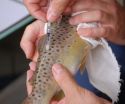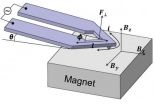(Press-News.org) TAMPA, Fla. (Jan. 12, 2012) – Using two cell surface markers found to be highly expressed in breast cancer lymph node metastases, researchers at Moffitt Cancer Center, working with colleagues at other institutions, have developed targeted, fluorescent molecular imaging probes that can non-invasively detect breast cancer lymph node metastases. The new procedure could spare breast cancer patients invasive and unreliable sentinel lymph node (SLN) biopsies and surgery-associated negative side effects.
Their study was published in a recent issue of Clinical Cancer Research (18:1), a publication of the American Association for Cancer Research.
"The majority of breast cancer patients, up to 74 percent, who undergo SLN biopsy are found to be negative for axillary nodal, or ALN, metastases," said corresponding author David L. Morse, Ph.D., an associate member at Moffitt whose research areas include experimental therapeutics and diagnostic imaging. "Determining the presence or absence of ALN metastasis is critical to breast cancer staging and prognosis. Because of the unreliability of the SLN biopsy and its potential for adverse effects, a noninvasive, more accurate method to assess lymph node involvement is needed."
The authors note that the postoperative complications to the SLN biopsy can include lymphedema, seroma formation, sensory nerve injury and limitations in patient range of motion. In addition, biopsies fail to identify disease in axillary lymph nodes in five to 10 percent of patients.
In developing targeted molecular probes to identify breast cancer in axillary lymph nodes, the research team from Moffitt, the University of Arizona and University of Florida used two surface cell markers – CAIX and CAXII. CAIX is a cell surface marker known to be "highly and broadly expressed in breast cancer lymph node metastases" and absent in normal tissues.
CAIX and CAXII are both integral plasma membrane proteins with large extracellular components that are accessible for binding of targeted imaging probes, explained Morse. In addition, several studies have shown that CAIX expression is associated with negative prognosis and resistance to chemo and radiation therapy for breast cancer. CAXII is a protein expressed in over 75 percent of axillary lymph node metastases.
The researchers subsequently developed their targeting agents by using monoclonal antibodies specific for binding CAIX and CAXII, both of which are known to promote tumor growth.
According to the researchers, a number of noninvasive optical imaging procedures for SLN evaluation have been investigated, but the approaches have lacked the ability to target tumor metastasis biomarkers.
"These methods provide only anatomic maps and do not detect tumor cells present in lymph nodes," explained Morse. "Using mouse models of breast cancer metastasis and a novel, monoclonal anti-body-based molecular imaging agents, we developed a targeted, noninvasive method to detect ALN metastasis using fluorescence imaging."
In addition to the imaging study with mice, the researchers also reported that the combination of CAIX and CAXII covered 100 percent of patient-donated samples used in their tissue microarray (TMA) study.
"The imaging probes detected tumor cells in ALNs with high sensitivity," explained Morse. "Either CAIX or CAXII were expressed in 100 percent of the breast cancer lymph node metasatsis samples we surveyed in this study. These imaging probes have potential for providing a noninvasive way to stage breast cancer in the clinic without unneeded and costly surgery."
###
About Moffitt Cancer Center
Follow Moffitt on Facebook: www.facebook.com/MoffittCancerCenter
Follow Moffitt on Twitter: @MoffittNews
Follow Moffitt on YouTube: MoffittNews
Located in Tampa, Florida, Moffitt Cancer Center is an NCI Comprehensive Cancer Center – a designation that recognizes Moffitt's excellence in research and contributions to clinical trials, prevention and cancer control. Moffitt currently has 14 affiliates in Florida, one in Georgia, one in Pennsylvania and two in Puerto Rico. Additionally, Moffitt is a member of the National Comprehensive Cancer Network, a prestigious alliance of the country's leading cancer centers, and is listed in U.S. News & World Report as one of "America's Best Hospitals" for cancer.
Media release by Florida Science Communications
END
For years, researchers seeking new therapies for traumatic brain injury have been tantalized by the results of animal experiments with stem cells. In numerous studies, stem cell implantation has substantially improved brain function in experimental animals with brain trauma. But just how these improvements occur has remained a mystery.
Now, an important part of this puzzle has been pieced together by researchers at the University of Texas Medical Branch at Galveston. In experiments with both laboratory rats and an apparatus that enabled them to simulate the impact of ...
Researchers at the University of Oviedo (Spain) have come up with a way of tagging gunpowder which allows its illegal use to be detected even after it has been detonated. Based on the addition of isotopes, the technique can also be used to track and differentiate between wild fish and those from a fish farm, such as trout and salmon.
A new method for tagging and identifying objects, substances and living beings has just been presented in this month's issue of the Analytical Chemistry journal. Its creators are scientists at the University of Oviedo who have patented the ...
A new study on African bats provides a vital clue for unravelling the mysteries in Australia's battle with the deadly Hendra virus.
The study focused on an isolated colony of straw-coloured fruit bats on islands off the west coast of central Africa. By capturing the bats and collecting blood samples, scientists discovered these animals have antibodies that can neutralise deadly viruses known in Australia and Asia.
The paper is published today, 12 January, in the journal PLoS ONE, and is a collaboration of the Department of Veterinary Medicine at the University of ...
Polymer nano-films and nano-composites are used in a wide variety of applications from food packaging to sports equipment to automotive and aerospace applications. Thermal analysis is routinely used to analyze materials for these applications, but the growing trend to use nanostructured materials has made bulk techniques insufficient.
In recent years an atomic force microscope-based technique called nanoscale thermal analysis (nanoTA) has been employed to reveal the temperature-dependent properties of materials at the sub-100 nm scale. Typically, nanothermal analysis ...
BOSTON, January 12, 2012: A research collaboration between the Wyss Institute for Biologically Inspired Engineering at Harvard University and Children's Hospital Boston has developed "smart" injectable nanotherapeutics that can be programmed to selectively deliver drugs to the cells of the pancreas. Although this nanotechnology will need significant additional testing and development before being ready for clinical use, it could potentially improve treatment for Type I diabetes by increasing therapeutic efficacy and reducing side effects.
The approach was found to increase ...
SANTA CRUZ, CA--Robotics experts at the University of California, Santa Cruz and the University of Washington (UW) have completed a set of seven advanced robotic surgery systems for use by major medical research laboratories throughout the United States. After a round of final tests, five of the systems will be shipped to medical robotics researchers at Harvard University, Johns Hopkins University, University of Nebraska, UC Berkeley, and UCLA, while the other two systems will remain at UC Santa Cruz and UW.
"We decided to follow an open-source model, because if all ...
University of Illinois researchers have shown that by tuning the properties of laser light illuminating arrays of metal nanoantennas, these nano-scale structures allow for dexterous optical tweezing as well as size-sorting of particles.
"Nanoantennas are extremely popular right now because they are really good at concentrating optical fields in small areas," explained Kimani Toussaint, Jr., an assistant professor of mechanical science and engineering at the University of Illinois at Urbana-Champaign. "In this work, we demonstrate for the first time the use of arrays ...
Racial discrimination may be harmful to your health, according to new research from Rice University sociologists Jenifer Bratter and Bridget Gorman.
In the study, "Is Discrimination an Equal Opportunity Risk? Racial Experiences, Socio-economic Status and Health Status Among Black and White Adults," the authors examined data containing measures of social class, race and perceived discriminatory behavior and found that approximately 18 percent of blacks and 4 percent of whites reported higher levels of emotional upset and/or physical symptoms due to race-based treatment. ...
The perception that women are scarce leads men to become impulsive, save less, and increase borrowing, according to new research from the University of Minnesota's Carlson School of Management.
"What we see in other animals is that when females are scarce, males become more competitive. They compete more for access to mates," says Vladas Griskevicius, an assistant professor of marketing at the Carlson School and lead author of the study. "How do humans compete for access to mates? What you find across cultures is that men often do it through money, through status and ...
Why do we like fatty foods so much? We can blame our taste buds.
Our tongues apparently recognize and have an affinity for fat, according to researchers at Washington University School of Medicine in St. Louis. They have found that variations in a gene can make people more or less sensitive to the taste of fat.
The study is the first to identify a human receptor that can taste fat and suggests that some people may be more sensitive to the presence of fat in foods. The study is available online in the Journal of Lipid Research.
Investigators found that people with ...



